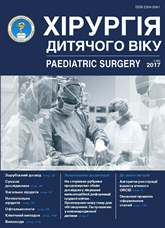Estimability of patient condition
DOI:
https://doi.org/10.15574/PS.2017.55.102Keywords:
patient condition, evaluation scale, childrenAbstract
This article presents a literature overview of the possibilities of patient condition estimation. There are many different systems and assessment scales of theseverity and the patient's potential risk of adverse outcomes, which are used in medical practice. The above mentioned systems and scales of evaluation
can be both unified and specific on nosology and age. Many evaluative scales are bulky and require fairly long time for carrying out the assessment and do
not allow to quickly determine the patient’s management plan. Both long running assessing process of the patient condition severity and development of
complications risk require the creation of a fairly simple and, at the same time, very informative evaluation system of the patient, prognosis for a disease
with the determination of the certain amount of medical invasions in the early hours of hospitalization to a medical institution. Therefore, the question of
universal assessment of a patient, especially a sick child, remains open and requires new solutions and proposals.
References
Abdominalna khirurhichna infektsiia: klinika, diahnostyka, antymikrobna terapiia: praktychne kerivnytstvo. Za red VS SavelEva, BR Gelfanda. (2006). Moskva, LIterra: 168.
Aleksandrovich YuS, Gordeev VI. (2007). Otsenochnyie i prognosticheskie shkalyi v meditsine kriticheskih sostoyaniy. Moskva, Sotis: 140.
Baraniv DA. (2012). Patomorfoz zbudnykiv hniino-septychnykh zakhvoriuvan u ditei i optymizatsiia likuvannia khvorykh. Avtoref dys … d-ra med nauk. Spets 14.01.19. Moskva: 30.
Hahloiev VM. (2008). Deiaki suchasni osoblyvosti hniinoi infektsii v ditei i rannia diahnostyka yii septychnykh proiaviv. Avtoref dis … kand med nauk. Spets 14.00.35. Sankt-Peterburg: 19.
Gusev EYu, Chereshnev VA, Yurchenko LN. (2007). Sistemnoe vospalenie s pozitsii teorii tipovogo patologicheskogo protsessa. Tsitokinyi i vospalenie. 6; 4: 9–21.
Dashtaiants HA. (1978). Klinichna hematolohiia. Kyiv: 230.
Kuselman AI, Samsyigin GA. (2012). Otsenka sostoyaniya tyazhesti bolnyih detey. Pediatriya. 91; 4: 115–121.
Nazarenko GI, Kishkun AA. (2002). Laboratorni metody diahnostyky nevidkladnykh staniv. Moskva: 567.
Nehaev IV, Prihodchenko AO, Mazurina OG. (2015). Poliorgannaya nedostatochnost, SSVR, DVS-sindrom i antitrombin III. Infektsii v hirurgii. 13; 1: 17–27.
Hain YuM, Khulun HIa, Zavada NV et al. (2005). Ob’iektyvna otsinka vahy stanu khvorykh i prohnoz u khirurhii. Minsk, Belmapo: 313.
Rebenok ZhO. (2009). Sepsys yak samostiine infektsiine zakhvoriuvannia. Infektsiini khvoroby. 2: 60–67.
Sepsys na pochatku XXI stolittia. Klasyfikatsiia, kliniko-diahnostychna kontseptsiia i likuvannia. Patoloho-anatomichna diahnostyka. (2004). Moskva, Yzd-U NTsSSKh ym AN Bakuleva RAMN: 126.
Nehaev IV, Prihodchenko AO, Mazurina OG. (2015). Poliorgannaya nedostatochnost, SSVR, DVS-sindrom i antitrombin III. Infektsii v hirurgii
Karpov IA, Kulagin AE, Gorbich YuL et al. (2014). Sepsis: diagnostika i podhodyi k antibakterialnoy i podderzhivayuschey terapii. Uchebno-metodicheskoe posobie. Minsk, BGMU: 48.
Sepsys: klasyfikatsiia, kliniko-diahnostychna kontseptsiia i likuvannia. Praktychne kerivnytstvo. Za red VS Savelieva, BR Helfanda. (2010). Moskva, Med ynform ah: 352.
Keyt Dzhenossi (2009). Sepsis: lechenie v usloviyah ogranichennyih vozmozhnostey. Update in Anaesthesia Education for anaesthetists worldwide. 14: 87–100.
Khirurhichni infektsii. Praktychne kerivnytstvo. Za red IA Eriukhyna, BR Helfanda, SA Shliapnykova. 2-e vyd, pererob i dop. (2006). Moskva, Literra: 736.
Chereshnev VA, Husiev EIu. (2012). Imunolohichni i patofiziolohichni mekhanizmy systemnoho zapalennia. Medychna imunolohiia. 14; 1–2: 9–20.
Shliapnykov SA, Stozharov VV, Zuieva LP et al. (2015). Osnovni pryntsypy zastosuvannia kliniko-statystychnykh hrup po likuvanniu vazhkoho sepsysu. Infektsii v khirurhii. 1: 3–10.
Bone RC, Balk RA, Cerra FB. (1992). Definitions for sepsis and organ failure and guidelines for the use of innovative therapies in sepsis: the ACCP/SCCM consensus conference committee Chest. 101: 1644–1655. https://doi.org/10.1378/chest.101.6.1481; https://doi.org/10.1378/chest.101.6.1644; PMid:1303622
Oostenbrink R, Moons KG et al. (2002). Children with meningeal signs. Predicting who needs empiric antibiotic treatment. Arch Pediatr Adolesc Med. 156: 1189–1194. https://doi.org/10.1001/archpedi.156.12.1189; PMid:12444828
Leteurtre S, Martinot A, Duhamel A et al. (1999). Development of a pediatric multiple organ dysfunction score: use of two strategies. Med Decis Making. 19: 399–410. https://doi.org/10.1177/0272989X9901900408; PMid:10520678
Solomkin JS, Mazuski JE, Bradley JS et al. (2010). Diagnosis and management of complicated intraabdominal infection in adults and children: guidelines by the Surgical Infection Society and the Infectious Diseases Society of America. Clin Infect Dis. 50(2): 133–164. https://doi.org/10.1086/649554; PMid:20034345
Wilkinson J, Pollack M, Ruttimann U et al. (1986). Outcome of pediatric patients with multiple organ system failure. Crit Care Med. 14: 271–274. https://doi.org/10.1097/00003246-198604000-00212; https://doi.org/10.1097/00003246-198604000-00002; PMid:3956214
Bosscha K, Reijnders K, Hulstaert PF et al. (1997). Prognostic scoring systems to predict outcome in peritonitis and intra-abdominal sepsis. Br J Surg. 84(11): 1532–1534. https://doi.org/10.1002/bjs.1800841110; https://doi.org/10.1111/j.1365-2168.1997.02809.x; PMid:9393271
Vincent JL, Moreno R et al. (1996). The SOFA (Sepsis-related Organ Failure Assessment) score to describe organ dysfunction/failure. Intensive Care Medicine. 22: 707–710. https://doi.org/10.1007/BF01709751; PMid:8844239
Downloads
Issue
Section
License
The policy of the Journal “PAEDIATRIC SURGERY. UKRAINE” is compatible with the vast majority of funders' of open access and self-archiving policies. The journal provides immediate open access route being convinced that everyone – not only scientists - can benefit from research results, and publishes articles exclusively under open access distribution, with a Creative Commons Attribution-Noncommercial 4.0 international license(СС BY-NC).
Authors transfer the copyright to the Journal “PAEDIATRIC SURGERY.UKRAINE” when the manuscript is accepted for publication. Authors declare that this manuscript has not been published nor is under simultaneous consideration for publication elsewhere. After publication, the articles become freely available on-line to the public.
Readers have the right to use, distribute, and reproduce articles in any medium, provided the articles and the journal are properly cited.
The use of published materials for commercial purposes is strongly prohibited.

